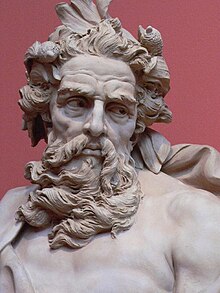Life and career
In 1723 Adam received the Prix de Rome for study at the French Academy in Rome, which gave him a year scholarship in Rome, where he studied the works of the greats including Bernini and restored with much ability and late-Baroque freedom of interpretation a disparate group of fragmentary Roman sculptures to form a much-admired ensemble depicting Achilles and the Daughters of Lycomedes [1] that was purchased by the French Ambassador to the Holy See, Cardinal Melchior de Polignac, and was purchased from his estate by Frederick the Great for Potsdam. For the ensemble Adam reworked draped torsos of Apollo Musagetes type for the figures of Odysseus and Achilles. The head of Achilles was modeled on the antiquarian Philipp von Stosch, "a notorious spy, homoerotic fop and gem collector" [2] Adam was elected a member of the Roman artists' guild, the Accademia di San Luca in 1732. [3]
He was a pensionnaire of the academy in 1732 when he was one of the 16 sculptors and designers who submitted plans for the new Trevi Fountain. His design was unanimously accepted, and the processes by which the decision was reversed in favor of Nicola Salvi and his student Luigi Vanvitelli are not altogether clear. Roman reaction against a foreigner receiving the commission seems to have played a part, as they in the interim selected then rejected Florentine sculptor Alessandro Galilei, [4] and in a letter of 1741 Adam wrote that not having received prior permission to compete from the director of the French Academy, Charles Wleughels, he was recalled home to Paris in 1733 as punishment. [5]
Adam was thirty-seven when, on his election to the Académie royale de peinture et de sculpture, he exhibited at the Paris Salon of 1737 the model of the colossal group of The Triumph of Neptune and Amphitrite that was afterwards (1740) cast in lead for the central fountain in the Bassin de Neptune at Versailles, and it made his reputation; [6] thereafter he found much employment in the decoration of the royal residences and in garden sculpture and fountains. He also restored with much ability the 12 statues (Lycomedes) found in the so-called Villa of Marius in Rome, and was elected a member of the Academy of St Luke. [8]
The dramatic realization of his figure of Neptune (illustration, below right) might lead one to expect that he would have been in demand for portrait busts; in fact, aside from the bust of the portraitist Hyacinthe Rigaud (1726), and two versions of the young Louis XV as Apollo, [9] none have been identified.
The work of the brothers Adam was too boldly Berniniesque in style to win the approval of the sculptors and critics of the following generation, that found its principal protagonists in Edmé Bouchardon and Jean-Baptiste Pigalle. [8] Pierre-Jean Mariette expressed the new taste in his severe criticism of the eldest of the Adam brothers:
- "This artist put into everything that he did a savage and barbarous taste and only rendered himself noted because one imagined that no one knew how to carve out marble as he did, and, to demonstrate it, he worked in such manner that everything formed hollows in his works. Thus do his figures have more the air of rockwork than of anything else at all." [10]
Two works
Two of his most important works were executed for Frederick the Great in Prussia. Mariette remarked of Adam's Hunting and Fishing, being sent to Frederick, that they "will not have lacked for admirers in a country where one does not yet completely know the value of beautiful and noble simplicity." [11]
The volume of a suite of etchings by various hands, after Adam's drawings, titled Recueil de sculptures antiques Grecques et Romaines [12] (Paris, 1754) represented a group of antiquities as broadly restored by Adam that he hoped to be able to sell. They remained in his possession and appear in the inventory of his atelier at No 4, rue Basse du Rempart, which was compiled at his death. [13]
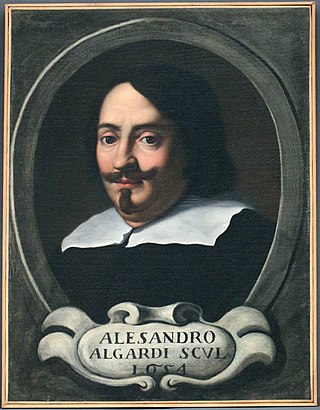
Alessandro Algardi was an Italian high-Baroque sculptor active almost exclusively in Rome. In the latter decades of his life, he was, along with Francesco Borromini and Pietro da Cortona, one of the major rivals of Gian Lorenzo Bernini, in Rome. He is now most admired for his portrait busts that have great vivacity and dignity.

Rococo, less commonly Roccoco, also known as Late Baroque, is an exceptionally ornamental and dramatic style of architecture, art and decoration which combines asymmetry, scrolling curves, gilding, white and pastel colours, sculpted moulding, and trompe-l'œil frescoes to create surprise and the illusion of motion and drama. It is often described as the final expression of the Baroque movement.

Giambologna, also known as Jean de Boulogne (French), Jehan Boulongne (Flemish) and Giovanni da Bologna (Italian), was the last significant Italian Renaissance sculptor, with a large workshop producing large and small works in bronze and marble in a late Mannerist style.

A fountain, from the Latin "fons", meaning source or spring, is a decorative reservoir used for discharging water. It is also a structure that jets water into the air for a decorative or dramatic effect.

Giovanni Angelo Montorsoli, also known as Giovann'Agnolo Montorsoli, was a Florentine sculptor and Servite friar. He is today as often remembered for his restorations of famous classical works as his original creations.

Adriaen de Vries (c.1556–1626) was a Northern Mannerist sculptor born in the Netherlands but working in Central Europe, whose international style crossed the threshold to the Baroque; he excelled in refined modelling and bronze casting and in the manipulation of patina and became the most famous European sculptor of his generation. He also excelled in draughtsmanship.
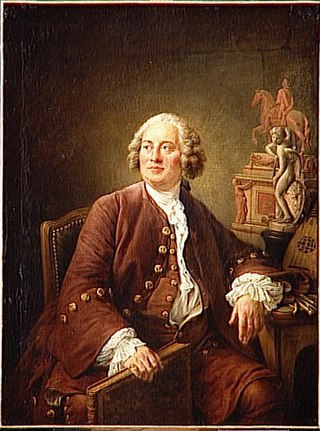
Edmé Bouchardon was a French sculptor best known for his neoclassical statues in the gardens of the Palace of Versailles, his medals, his equestrian statue of Louis XV of France for the Place de la Concorde ; and for the Fountain of Four Seasons in Paris. He was also a draftsman and painter, and made celebrated series of engravings of working-class Parisians.
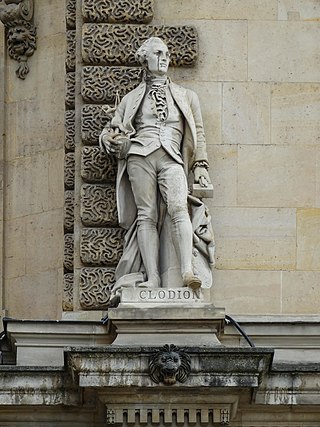
Claude Michel, known as Clodion, was a French sculptor in the Rococo style, especially noted for his works in marble, bronze, & terracotta.
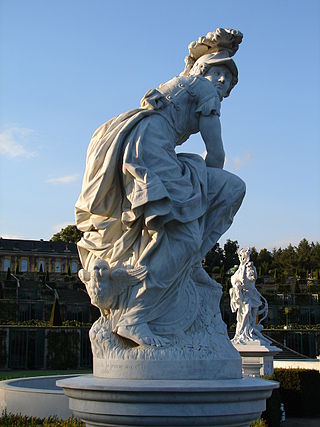
François Gaspard Adam was a French rococo sculptor.

The Château de Choisy was a royal French residence in the commune of Choisy-le-Roi in the Val-de-Marne department, not far from Paris. The commune was given its present name by Louis XV, when he purchased the manor of Choisy and its château in October 1739.

Pietro Bracci was an Italian sculptor working in the Late Baroque manner. He is best known for carving the marble sculpture of Oceanus at the center of Rome's Trevi Fountain, based on a plaster modello by Giovanni Battista Maini.

Pierre Le Gros was a French sculptor, active almost exclusively in Baroque Rome where he was the pre-eminent sculptor for nearly two decades.
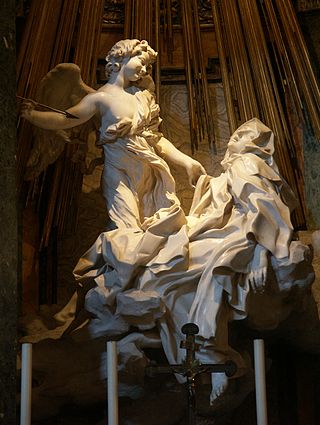
Baroque sculpture is the sculpture associated with the Baroque style of the period between the early 17th and mid 18th centuries. In Baroque sculpture, groups of figures assumed new importance, and there was a dynamic movement and energy of human forms—they spiralled around an empty central vortex, or reached outwards into the surrounding space. Baroque sculpture often had multiple ideal viewing angles, and reflected a general continuation of the Renaissance move away from the relief to sculpture created in the round, and designed to be placed in the middle of a large space—elaborate fountains such as Gian Lorenzo Bernini‘s Fontana dei Quattro Fiumi, or those in the Gardens of Versailles were a Baroque speciality. The Baroque style was perfectly suited to sculpture, with Bernini the dominating figure of the age in works such as The Ecstasy of St Theresa (1647–1652). Much Baroque sculpture added extra-sculptural elements, for example, concealed lighting, or water fountains, or fused sculpture and architecture to create a transformative experience for the viewer. Artists saw themselves as in the classical tradition, but admired Hellenistic and later Roman sculpture, rather than that of the more "Classical" periods as they are seen today.

The Fontana delle Tartarughe is a fountain of the late Italian Renaissance, located in Piazza Mattei, in the Sant'Angelo district of Rome, Italy. It was built between 1580 and 1588 by the architect Giacomo della Porta and the sculptor Taddeo Landini. The bronze turtles around the upper basin, usually attributed either to Gian Lorenzo Bernini or Andrea Sacchi, were added in either 1658 or 1659 when the fountain was restored.
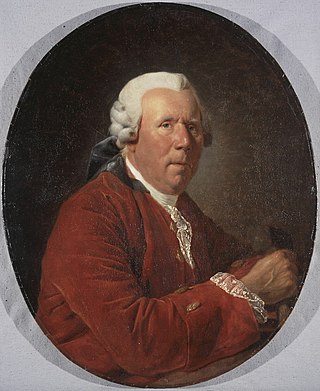
Nicolas-Sébastien Adam, also called "Adam the Younger", was a French sculptor working in the Neoclassical style. He was born in Nancy and died in Paris.
Gregorio Zappalà was an Italian sculptor.

François Dumont was a French sculptor.
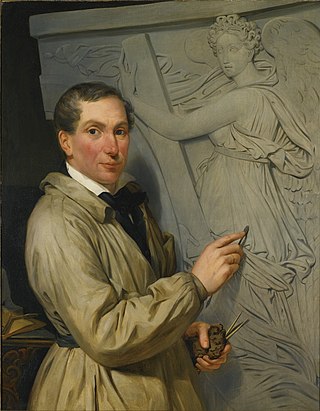
Charles-René Laitié was a French sculptor.

French sculpture has been an original and influential component of world art since the Middle Ages. The first known French sculptures date to the Upper Paleolithic age. French sculpture originally copied ancient Roman models, then found its own original form in the decoration of Gothic architecture. French sculptors produced important works of Baroque sculpture for the decoration of the Palace of Versailles. In the 19th century, the sculptors Auguste Rodin and Edgar Degas created a more personal and non-realistic style, which led the way to modernism in the 20th century, and the sculpture of Pablo Picasso, Georges Braque, Marcel Duchamp and Jean Arp.

